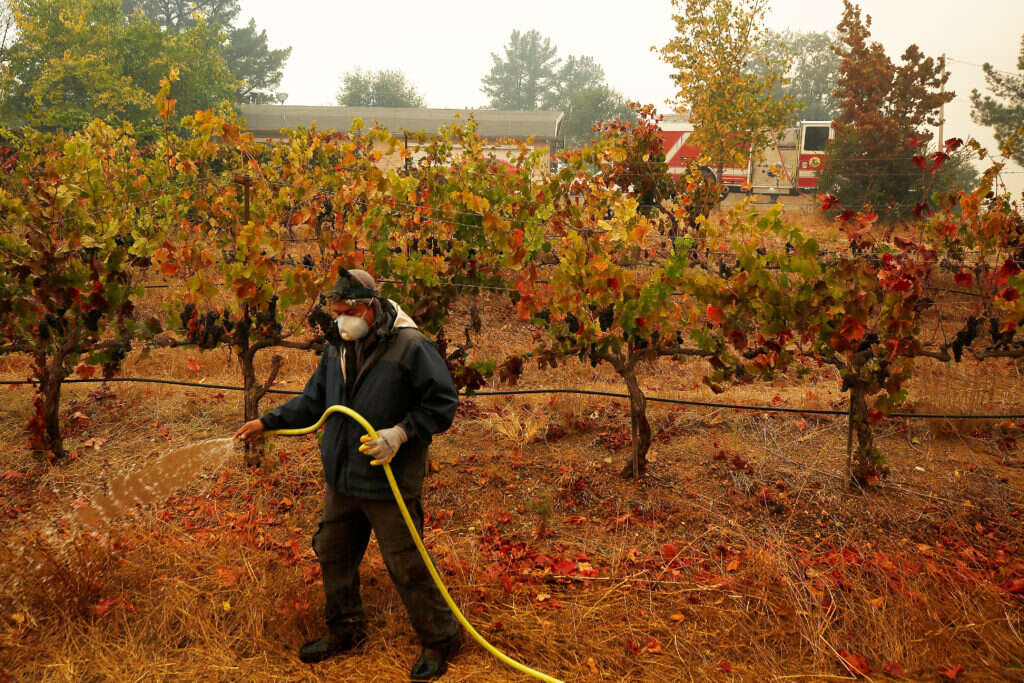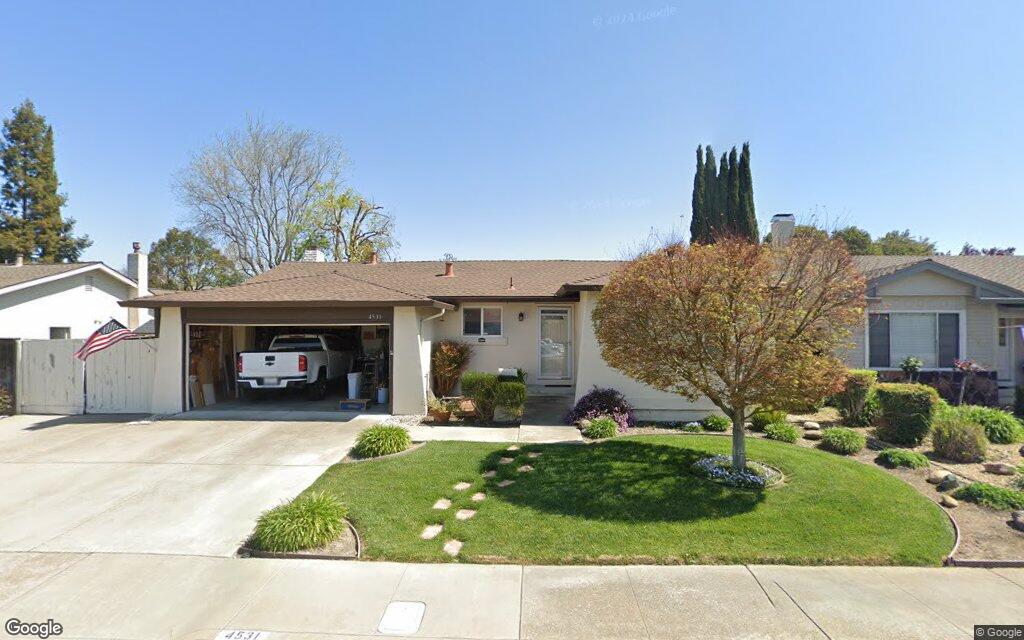A newly published UC Berkeley study takes a highly critical view of Sonoma County’s Ag Pass program, adding to previous analyses that suggest the system, which allows agricultural workers into disaster evacuation zones when approved by the Sheriff’s Office, keeps local industry humming at the expense of worker health and safety.
Among the findings of a survey of more than 1,000 Sonoma County farmworkers presented in the article published Oct. 20 in the Journal of Agromedicine:
• 75% of respondents said they had done agricultural work during an active wildfire, or in the presence of wildfire smoke.
• 37% said their employers had not provided them with any personal protective equipment while they were working during fires.
• 66% said their health was affected by working during wildfires, with 83% of those citing eye irritation, 75% reporting headaches and 45% shortness of breath.
• 57% said they felt sick but continued to work because they couldn’t afford the lost income, and 51% said they did so because they were afraid of losing their jobs.
• Only 25% said they would feel safe gathering more information and signing up for the program through the Sheriff’s Office.
Related Articles
PG&E CEO sees no credit upgrades until California fire season ends
Man accused of setting what became the Palisades fire makes 1st courtroom appearance
The most important things Bay Area residents can do to protect their home against wildfires
As wildfires scorch California, should insurers divest from fossil fuels?
New California laws aim to ease ongoing home insurance crisis
“Our research … identifies how the county developed a program that expanded access to agricultural workers but in practice primarily meets the needs of owners/operators,” wrote the study’s primary authors, Linda T. Gordon of the Berkeley Human Rights Center and Carly Hyland in the School of Public Health, in an accompanying white paper.
Karissa Kruse, president and CEO of the Sonoma County Winegrowers trade association, insisted the program works, including for the laborers who help power the region’s farm economy.
“Through our ongoing relationships and direct feedback from vineyard employees via the Fundación de la Voz de los Viñedos, the experiences shared by Sonoma County’s vineyard workforce differ from what is reflected in this study,” Kruse added. “Safety has always been — and will always remain — our farmers’ top priority.”
Earlier this year, Sonoma County Sheriff Eddie Engram signaled to the Board of Supervisors Ag Pass program is faltering in part because of the comparatively few farmworkers enrolled.
The study team proposed its own changes to the program. Many of them are aimed at county leadership.
The researchers advocate consulting health professionals, such as the Sonoma County health officer who serves as the top local public health official, and monitoring air quality and heat levels in deciding when and where the Ag Pass should be activated. The Sheriff’s Office currently makes that call, in consultation with Cal Fire and other emergency agencies.
The authors also suggest removing law enforcement altogether from the Ag Pass application process, reassigning oversight of the program’s safety training from that agency to organizations with expertise in public health, wildfire safety and “competency interacting with a predominantly immigrant workforce,” and increasing information distributed in Spanish and Indigenous languages.
There are recommendations at the state level, too. The researchers urge Cal/OSHA to pass legislation that provides wage replacement for farmworkers when prolonged outdoor physical activity is deemed unhealthy, so they don’t feel pressured to work.
The study is likely to revive debate about a program that has faced pushback from farm labor advocates and health officials from the start, for many of the same reasons outlined by the Berkeley researchers.
While agricultural access programs here and elsewhere apply to a wide range of livestock, crops and types of natural disaster, in Sonoma County the discussion tends to focus on the grape harvest and destructive wildfires — two occurrences that have coincided across a number of seasons over the past decade especially, forcing difficult choices for employers and employees alike.
Grape growers group responds
Kruse, the winegrowers group executive, argued that the survey guiding the study “appeared to have a limited reach” because, she said, it was aimed at day laborers, rather than including the full-time vineyard employees who are eligible to participate under the Ag Pass program.
The winegrowers shared these concerns when the researchers reached out to them early in the process, Kruse said. But “after that initial exchange, we were not given the opportunity to provide additional input.”
In exchanges with The Press Democrat, the study’s co-authors were surprised by Kruse’s assertions.
Hyland said the survey team explicitly enrolled only people who had worked full time in agriculture in Sonoma County since 2017. And Gordon, her fellow Cal researcher, said they invited Kruse to community forums held in Sonoma County a year ago, to discuss preliminary findings and recommendations.
“We had attendance from the California Association of Winegrape Growers and the Wine Institute,” Gordon said, referring in the latter case to the independent advocacy group for the wine industry. “They were active participants and gave great feedback that informed our recommendations. We reached out to (the Sonoma County Winegrowers), and their organization just didn’t respond.”
Kruse countered, saying one of her colleagues registered for and attended the event because she was out of town at the time. By then, Kruse said, the survey work was done and it was too late to help shape it.
Sonoma County’s Ag Pass program, first instituted in 2022, was an outgrowth of multiple years of catastrophic wildfires overlapping weeks of the region’s grape harvest. Authorities and employers had no way to coordinate access for farm laborers into closed evacuation zones at the time, resulting in situations that advocates at the time said put workers at risk.
The workers have also voiced concerns about the economic hardship that results from missing days of work. The Ag Pass program sought to address that by offering exemptions to the blanket bans on access.
Many areas of California are wrestling with similar dilemmas as floods, fires and other natural disasters extend across a greater portion of the year and grow in intensity under the effects of climate change.
State lawmakers in 2021 passed Assembly Bill 1103, clarifying how livestock operators might enter evacuation zones for essential work.
Program expanded but seldom used
The Sonoma County Board of Supervisors in 2022 expanded the local program to include all full-time employees, in a wider range of agricultural operations. And in September 2023, following intensive lobbying by farm interests and a contentious debate in the board chambers, the supervisors voted 3-2 to expand the definition once again. This time they added harvest work to “critical agricultural activities.”
Gordon and Hyland called this “a pivotal shift.” As of December 2024, Sonoma and Napa were the only counties to approve Ag Passes for harvesting.
But while the state and its counties were carving out access programs, academics were sounding the alarm about harmful pollutants cast into the air during wildfires, most notably the fine particulate matter associated with a range of respiratory and cardiovascular diseases. And among the most exposed groups were farmworkers, many of whom labored without health insurance or waived services for fear of putting themselves at greater risk of detention by immigration authorities.
During the three-month survey period for the Berkeley study, the current version of Sonoma County’s Ag Pass had not been needed or activated, with the North Bay largely dodging the kind of catastrophic fires and floods that ravaged the 2017-2020 period. (The new version has been activated just once, during the Point Fire in June 2024.) So Gordon, Hyland and their fellow researchers set out to ask farmworkers about their general wildfire experiences.
For help, they turned to Zeke Guzman, president of the farmworker advocacy group Latinos Unidos del Condado de Sonoma.
Working together, they established a six-person community-engagement team made up of nonprofit and health leaders. And they fanned out to churches, health clinics and homes to distribute questionnaires.
In the spring of 2024, the team collected 1,011 surveys.
In addition to the data collected, the researchers interviewed 10 participants in depth. Their responses, many of which were presented in the paper, are telling.
“I remember that on one occasion, I told my employer that I was not able to go to work because I was sick but he said that I had to go,” one worker said. “So then I had to go work and I was really close to where the wildfires were at, and … I came back with a fever and headaches.”
“When we go to the doctor’s, we have to miss work and our employers do not agree because we miss too many hours or days of work,” another said. “Or we do not have enough money to pay expensive medical bills.”
Past scrutiny of program
The Journal of Agromedicine article isn’t the first academic paper to question Sonoma County’s agricultural access rules for disaster zones.
A report released by the UC Irvine School of Social Ecology in May 2022 counted close to 300 farmworkers who’d been sent inside evacuation zones during the 2020 LNU Lightning Complex fires and the Glass Fire. That number was unreliable, the authors suggested, because of the way Ag Pass information was collected at the time.
And a study published by the American Geophysical Union in July 2024 compared data from different air quality monitors during the 2020 Sonoma County wildfires, and found that farmworkers were exposed to high pollution levels that varied sometimes vineyard by vineyard.
The authors of that paper suggested placing real-time air quality monitors at worksites, and encouraged employers to offer time-and-a-half hazard pay for any complete 6-hour shift if the Air Quality Index was above 150, which corresponds to the “Unhealthy” level, at any point within the previous 24 hours.
A handful of wineries in Sonoma and Napa counties have voluntarily adopted that pay standard.
In Sonoma County, the Department of Agriculture/Weights and Measures is responsible for administering and reviewing Ag Pass applications. The Sheriff’s Office sets minimum training standards, and handles photo registration and distribution of physical passes.
Crucially, the sheriff is solely responsible for activating and deactivating the Ag Pass option when an evacuation is in effect.
The program has been plagued by lack of participation. As of April 25, according to a presentation by Sonoma County Agricultural Commissioner Andrew Smith to the Board of Supervisors in June, the county had received 750 Ag Pass applications and had issued 423 passes, with another 28 pending. Smith did not respond to requests for updated numbers.
That represents a small fraction of the estimated 6,000-10,000 farmworkers in Sonoma County.
The role of the Sheriff’s Office has been controversial from the start, with farmworker advocates claiming the workers are uncomfortable working with law enforcement.
Sheriff Engram acknowledged those concerns at the June 3 supervisors’ meeting, noting that the names and addresses of Ag Pass recipients become publicly available information.
“I think what we’ve done with creating this de facto registry of agricultural workers kind of runs contrary to the board resolution (pledging support for immigrant communities) in January,” the sheriff told the board.
With these limitations, along with hesitancy among some employers, Engram said, “I don’t see the program growing. Quite honestly, I probably see the program shrinking. We have taken a program that was working, and we have made it burdensome and it’s not working.”
Under the old system, job supervisors were issued training certificates and held responsible for any employees they brought into evacuation zones. Law enforcement officers made the key decisions at checkpoints, but did not interface directly with laborers.
Correction (2:40 p.m., Oct. 24, 2025): This story has been updated to clarify that the Wine Institute mentioned as a participant in forums for the wildfire exposure study is the independent advocacy organization for the wine industry, not the academic hub at Sonoma State University by the same name.
You can reach Phil Barber at 707-521-5263 or [email protected]. On X (Twitter) @Skinny_Post.
You can reach Staff Writer Martin Espinoza at 707-521-5213 or [email protected]. On X (Twitter) @pressreno.





